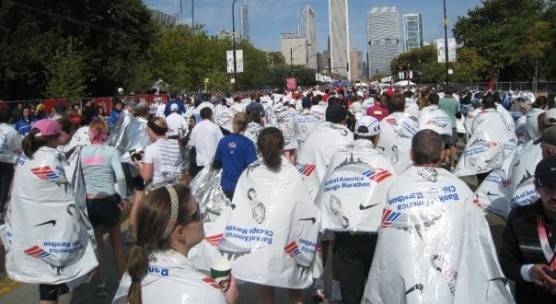 Running, you might think, is a green sport. You put one foot in front of the other; you drink water. How much greener can you get? Think the original Greek Ancient Olympic Games, nearly three thousand years ago, when runners had no shoes, ran naked, and bib numbers, well…where would you pin them? Green, right? Fortunately, running today, and races in particular, are low impact, but they are far less green than you’d think.
Running, you might think, is a green sport. You put one foot in front of the other; you drink water. How much greener can you get? Think the original Greek Ancient Olympic Games, nearly three thousand years ago, when runners had no shoes, ran naked, and bib numbers, well…where would you pin them? Green, right? Fortunately, running today, and races in particular, are low impact, but they are far less green than you’d think.
Running shoes, water bottles, water cups, safety pins for bibs, the bibs themselves, finisher medals, the coveted race shirt made in the Philippines…all of these things impact the environment, and some stick around for many years after our knees have given out and we have stopped running. Races produce a lot of waste; the bigger the race, the larger the footprint.
For example, the Christie Clinic Illinois Marathon brought nearly 15,000 runners through the streets of Champaign-Urbana, but it also used 12,000 gallons of water, 190,000 cups, 15,000 water bottles, 70,000 safety pins, and 400 trash bags carrying untold amounts of race waste and recyclables, this according to Jan Seeley, the marathon’s race co-director. All of that waste needs to go somewhere. Some of it, like the water bottles, was recycled. Other items, like race signs, will be used again another year. But other things, like most everything else, aren’t recycled. Seeley hopes to do even better next year. “We would like to have a new member of our race committee become the GREEN team leader and spearhead greater efforts to keep/make the race greener,” she said.

Making races green takes work, and some just don’t do it. Smaller races, in some respects, are worse off. Where the Illinois Marathon has the resources to recycle water bottles, lower its carbon footprint, and think ahead for next year, smaller races simply don’t have the resources, manpower, or incentive to do so. This is especially true as these races are put on by small operations, in many cases looking to raise money for a particular cause. Garbage is garbage. It’s part of putting on a race.
“I don’t think race size matters in being green,” Seeley said. She has spoken before groups of other race directors around the country about ways they can make races, big or small, more environmentally friendly. Some things they can do include:
- Print race announcements on recycled paper
- Provide online registration only
- Offer eco-friendly, chemical-free t-shirts
- Use bibs that use soy ink
- Collect old running shoes and donate them to charities
- Encourage reuse of goody bags in other ways after the race
- Suggest carpooling to and from the race
- Require runners to carry their own water in reusable water bottles from home
- Make composting bins available for post-race fruit waste (think banana peels)
- Offer awards made by local businesses with local products
One race that is trying to shrink its footprint is the Allerton Park Trail Run. Put on by the Second Wind Running Club (of which the author ― yours truly ― is a board member), the race has stepped it up a notch by going low impact in its signature race. It takes place at the University of Illinois’ Allerton Park in Monticello on October 31st ― Halloween. With an expected field of roughly 500 athletes, it is small in the grand scheme of things, but it is fairly sizable by east central Illinois racing standards.
 “Rather than going all out and changing every aspect of the race to label it ‘green’ we have decided to just keep environmental considerations a top priority of our planning,” says Ben Newell, one of the race directors. “I would call it a low impact race rather than green. Some specific things we are doing/have done are aiming for 100% online registration, eliminating bottled water and race packets, encouraging carpooling, and reusing bib pins. “
“Rather than going all out and changing every aspect of the race to label it ‘green’ we have decided to just keep environmental considerations a top priority of our planning,” says Ben Newell, one of the race directors. “I would call it a low impact race rather than green. Some specific things we are doing/have done are aiming for 100% online registration, eliminating bottled water and race packets, encouraging carpooling, and reusing bib pins. “
Seeley’s list, originally geared towards race directors, can help you, as a runner, be more eco-friendly come race day. Registering online, if available, reduces paper waste. Choosing a no t-shirt option if one is available reduces the need for something you might not wear. And if you do get one and don’t need or want it, donate it to a local charity. Reuse and/or bring your own bib pins. How much do 75,000 safety pins weigh? People reusing them at other races helps keep them out of the landfills. Carpool with a friend to your next race. “The largest impact, I think, can be made by the runners themselves,” Newell said.
Races like the Illinois Marathon and the Allerton Park Trail Run are taking steps to be more eco-friendly. What will you do to make your running green?








